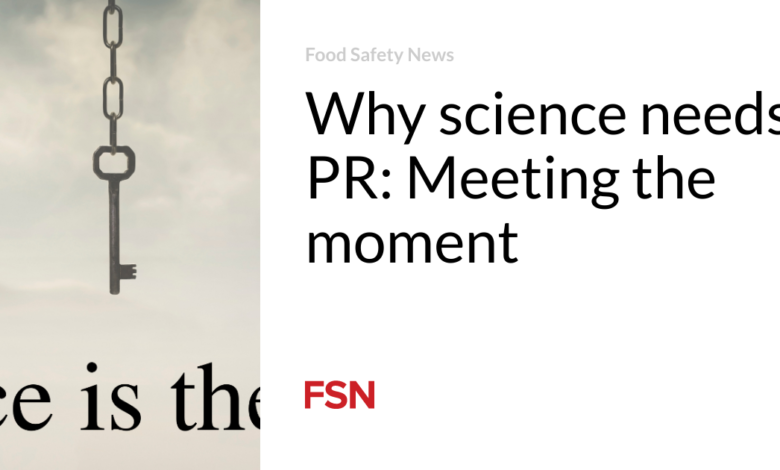Why science needs PR: Meeting the moment

— OPINION —
By Steve Gibb, MS
Science needs a publicist, and badly. How badly? One can only conclude from reading newspapers that false narratives are increasingly considered normal and acceptable. And we’re not talking about selective emphasis here but bald-faced untruths. Dishonesty is problematic not only because it’s disrespectful and manipulative but because it pollutes discourse with inaccuracies and mistrust. It also leads to unfounded fears and stress. We need facts to navigate and survive and are robbed of this by lies – at a critical moment in our planet’s collective history. The misinformation and disinformation crisis infecting much public discourse today must be curtailed if we hope to see through the glass darkly.
Still respected
Science has a history of respect and legitimacy supported by valid data collection methods and the peer review process that could be more effectively leveraged for better outcomes. It is a process that should transcend bias. Good data that are collected according to sound scientific principles don’t lie. Medicine, our diet and our climate health can all benefit from scientifically rigorous research, including food science. However, publication is often the final step for researchers in this process, not dissemination. Most research remains on library shelves and in the Cloud, limiting its utility and impact. Taking more steps to mobilize scientific knowledge on beyond appearing in PubMed and peer-reviewed journals makes more room for the growth of evidence-based policymaking. It can also start transformative conversations among professionals and leaders.
Knowledge mobilization for the Institute for the Advancement of Food & Nutrition Sciences (IAFNS) is a key tool that is utilized to promote scientifically informed policy and practice. This involves crafting a news release on scientific findings. Each news release typically includes several take-away messages, quotes from the researchers and a ‘free to read’ link to the original published science paper (i.e. not behind a paywall). Transparency on data sources, funding and scientific integrity are key. From there IAFNS’ brainstorms: what audiences would resonate or benefit from the new information? Food safety professionals? Dietitians? Doctors? Food processors? Government scientists? And we’re off and running sharing the news release link with those audiences, reporters, thought leaders, associations and conference attendees that can further mobilize the new knowledge. It’s less a sales pitch than a sort of pollinator role, distributing information where it’s needed instead of trying to ‘look good’ through PR tactics. At IAFNS, earned media counts when the science we support is cited in the press, not the IAFNS name.
Know your mob
When communicating science, knowing which audiences are interested is key. Note I didn’t say “target” audiences – communication in our experience is less war-like and more cooperative and collaborative. At IAFNS we seek input from academics, industry and government leaders as we select and fund actionable, impactful food safety and nutrition research. In the process, we identify who would find the information important, interesting and practical.
We team up with the paper’s primary authors to explore whether their university or company is also willing to issue a news release on the new science, or plug ours. This often helps amplify the knowledge, however care must be taken to make sure the science is being elevated rather than an institution or investigator. We then reach out to our partners in media outlets, association newsletters and websites, blogs and social media channels that those potentially interested groups read. For example, a paper we supported on optimizing sampling of powdered foods boosts food safety and garnered a lot of press. The onus is on us to convey the right technical information to food safety professionals who work with powdered foods, some of which are consumed by infants and children. With knowledge comes responsibility.
TIP the scales toward utility
The opportunity cost is great when we do not share what we know with audiences who can put it to use. Large investments of tax dollars lie dormant in libraries and online databases. Thankfully, the National Science Foundation is alert to this and with new Congressional funding has started the TIP Directorate to make its science more useful through collaborations and partnerships. NSF’s new Directorate for Technology, Innovation and Partnerships holds promise for advancing competitiveness and addressing pressing societal and economic challenges. And by 2025, other federal agencies must make research funded by taxpayers publicly accessible, increasing the opportunities for mobilizing knowledge.
More partners are needed to publicize science and make it useful in a world where hyperbolic bias sometimes seems to reign. Science needs your help. Advertise it. Summarize it. Talk about it. Mobilize it. It can make a difference in the lives of your students, customers and other people you care about.
About the author: Steve Gibb is a science communications manager at IAFNS, which supports food safety and nutrition research. He previously worked at Bloomberg News and at the National Academy of Sciences.
(To sign up for a free subscription to Food Safety News,click here)



